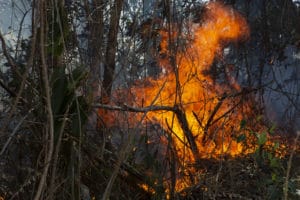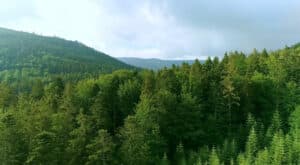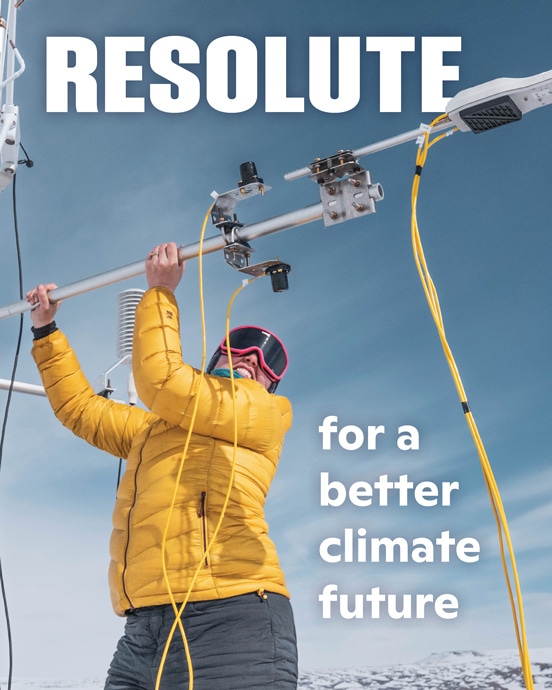Air quality monitoring to machine learning: Fund for Climate Solutions awards six new grants
The second round of 2024 Fund for Climate Solutions (FCS) awardees has been announced. The FCS advances innovative, solutions-oriented climate science through a competitive, internal, and cross-disciplinary funding process. Generous donor support has enabled us to raise more than $10 million towards the FCS, funding 69 research grants since 2018. The latest cohort of grantees includes three projects focused on driving impact through collaboration and community-building, and three projects exploring new horizons in technology with timely policy relevance.
Arctic wildfire pollutants: Towards improving emissions estimates and developing tribally-led monitoring
Lead: Scott Zolkos
Collaborators: Brendan Rogers, Sue Natali, Kyle Arndt, Elise Sunderland (Harvard University)
Increasing wildfire activity in northern high-latitude regions is threatening global climate goals and public health. When organic matter in soils and vegetation burns, greenhouse gasses, fine particulates (PM2.5), and contaminants including mercury are released to the environment. Currently, there is sparse data for understanding how wildfires contribute to the northern mercury cycle, as well as gaps in infrastructure for monitoring PM2.5 in Alaska Native communities. This project will develop a network to measure and monitor the release of mercury and PM2.5 from wildfire, with an emphasis on peatlands. Leveraging ongoing work by Permafrost Pathways, the team will install mercury sampling equipment on existing eddy covariance flux towers across Alaska and Canada. Alongside Permafrost Pathways and their tribal partners, the team will also consult with Alaska Native communities in the Yukon-Kuskokwim Delta to co-develop a tribally-led air quality monitoring program.
Workshop: Innovative sensors and applications in environmental research
Lead: Kathleen Savage
Collaborators: Zoë Dietrich, Marcia Macedo
Many of the Woods Hole science community’s cutting-edge researchers, including several scientists at Woodwell Climate, are developing creative, do-it-yourself (DIY) tools using relatively simple components to further explore their research questions. However, despite the six institutions’ similar applications and geographic proximity, there are few opportunities for exchange and knowledge, both across Woods Hole institutions and more broadly with Cape Cod educational institutions. The project team will convene a one-day workshop to bring together aquatic, atmospheric, and terrestrial science researchers and educators from the Woods Hole science community and local community colleges. The event will focus on three main themes: development of new sensor systems that use existing technologies in novel ways; new data storage or transmission solutions; and community initiatives to facilitate continued creation and sharing of new technologies. Sessions will foster knowledge exchange, build networks, and develop community resources focused on innovative DIY research solutions, and a hybrid virtual option will be offered for oral presentations to broaden participation.
Soil Spectroscopy for Global Good network
Lead: José Lucas Safanelli
Collaborators: Jonathan Sanderman
The Soil Spectroscopy for Global Good (SS4GG) initiative is a collaborative network of hundreds of soil scientists and others focused on using soil spectroscopy as a means to generate high-quality soil data at significantly reduced costs. It was created in 2020 by the Woodwell Climate Research Center, the University of Florida, and the OpenGeoHub Foundation (the Netherlands) with support from many national and international institutions and researchers. SS4GG created and supports the Open Soil Spectral Library (OSSL), an open source of soil spectroscopy data, and a broad community of practitioners uses the library and collaborates on related science. This award will extend the activities of the SS4GG initiative with a focus on training and further engagement with the soil science community. The project team will continue to add data sets and new models to the OSSL, as well as engage with the soil science community by attending international conferences and providing a training workshop. The funds will also support hosting a visiting soil biogeochemist at the Woodwell Climate campus—Dr. Raj Setia from the Punjab Remote Sensing Center.
Pathways of carbon metabolism under cover crops
Lead: Taniya RoyChowdhury
Collaborator: Jonathan Sanderman
Sequestering, or capturing carbon in soils has a high potential to mitigate climate change. It is challenging to specifically predict how successful carbon sequestration may be, as current models used to evaluate agronomic management oversimplify soil microbial properties. This project will test for the key pathways of carbon transformations using soil samples taken under cover crops from a long-term study site. The team will quantify the chemical diversity of carbon substrates that microbes in the soil take up, and use data mining to predict the impacts of that diversity on soil carbon sequestration and nutrient cycling. The research outcomes will also lay a foundation for future collaborative research within the Department of Energy scientific community, and the soil health research community more broadly.
Bringing confidence to carbon markets through improved monitoring
Lead: Seth Gorelik
Collaborator: Wayne Walker
The protection, improved management, and restoration of forests are key nature-based solutions to the climate crisis, yet implementation and maintenance of these forest-based solutions requires sustainable and substantial financing. The voluntary carbon market (VCM) has the potential to deliver the necessary level of financing; however, a significant gap exists between its potential and actual performance. Improving the accuracy of forest carbon monitoring is crucial for the VCM to deliver effective, meaningful climate change mitigation. This project will enhance the credibility and effectiveness of forest carbon markets by evaluating new remote sensing methods for measuring forest carbon and showing that these methods provide more robust data than the conventional approach. Research findings could lead to updated global standards and policies for issuing carbon credits, which would increase market confidence and promote sustainable forest management.
Applying machine learning models to link river hydrology and fire risk forecasting in the Amazon
Lead: Andrea D. de Almeida Castanho
Collaborators: Michael Coe, Marcia Macedo
In recent decades, extreme drought events have increased forest flammability, fire severity, and the likelihood of fire escaping and spreading into adjacent forests and working lands, as illustrated by the wildfires seen throughout Amazonia during the 2023-24 drought. The project team will explore the potential of using river stage (water level) data as a proxy for landscape dryness, to ultimately reveal the short-term risk of wildfires spreading into forests. If confirmed, this innovative hypothesis could provide the scientific basis for developing new metrics of river stage to improve early-warning systems that forecast high fire risk days to weeks in advance. These improvements would create benefits not only for tropical forest protection, but also for biodiversity, greenhouse gas emissions, and human health.
George M. Woodwell Celebration of Life
With the passing of Dr. George Woodwell on June 18, 2024, we lost a pioneer and a visionary, a deeply good person, and for many in our community, a mentor and dear friend. Dr. Woodwell’s Celebration of Life took place on July 26, 2024 at Woodwell Climate Research Center in Falmouth, MA.
Watch the recording on YouTube.
Extreme heat is wilting and burning forests, making it harder to curb climate change
High temperatures, droughts and wildfire last year caused some forests to wilt and burn enough to degrade the ability of the land to lock away carbon dioxide.

Earth’s land lost much of their ability to absorb the carbon dioxide humans pumped into the air last year, according to a new study that is causing concern among climate scientists that a crucial damper on climate change underwent an unprecedented deterioration.
Temperatures in 2023 were so high — and the droughts and wildfires that came with them were so severe — that forests in various parts of the world wilted and burned enough to have degraded the ability of the land to lock away carbon dioxide and act as a check on global warming, the study said.
Read more on The Washington Post.
Hurricane season in North America is underway. Already, the second storm of the year to earn a name, Beryl, has cut a destructive swath across the Caribbean and the United States. This year, the National Oceanic and Atmospheric Administration (NOAA) forecasted an extremely active hurricane season, anticipating between 17-25 named storms (the average is 14) and 4-7 major storms (average is 3). Major storms are category 3 and above with wind speeds exceeding 111 mph.
Intense seasons like this are likely to be a more common occurrence in a warmer world, as higher temperatures, rising seas, and changing weather patterns create the conditions for bigger, more destructive, longer lived, and more rapidly strengthening storms. Here’s how climate change is affecting the Atlantic hurricane season:
1. Higher temperatures mean more energy to form hurricanes
To understand how hurricanes are being affected by climate change, it’s important to understand how hurricanes are formed. They are essentially clusters of thunderstorms, building strength as they sweep westward using the energy from warm tropical waters. Under the right conditions, the Earth’s rotation will cause the cluster to spin into a cyclone shape. Because heat is energy, increases in sea surface temperatures play a critical role in strengthening these storms.
The ocean is a major heat sink for the planet, absorbing over 90% of the excess heat trapped by greenhouse gasses in the Earth’s atmosphere over the past few decades. Global sea surface temperatures have increased approximately 2.8F since the beginning of the 20th century, and ocean heatwaves — large areas of above-normal temperatures that can last for months-– are much more common and widespread. A hotter ocean means there is more energy available to fuel tropical storms, ultimately making it a more destructive event when it hits land.
2. The hotter the air, the more water it can hold
The second thing a hurricane needs to form is moisture. Water is evaporated and pulled up into the developing storm as it spins across warm waters of the tropical Atlantic. Hotter air temperatures mean more moisture can be held as vapor in the atmosphere, which allows storms to ingest greater amounts of water that will eventually condense into clouds and be released as rainfall. Condensation also releases heat into the storm, fueling its intensification. Models estimate that human-caused global warming has increased hurricane extreme hourly rainfall rates by 11%.
3. ENSO fluctuations are becoming more extreme
Climate change is also contributing to larger swings between the two phases of the El Niño Southern Oscillation (ENSO)—meaning stronger versions of both El Niño or La Niña patterns. Currently, the Atlantic is headed towards a La Niña, which favors hurricane formation because it lessens vertical wind shear. Differences in wind speeds at different heights in the atmosphere can tear a storm apart, while less shear (more consistency in wind speeds between altitudes) allows storms to stay together and build strength.
4. Tropical storms are undergoing rapid intensification more frequently
All these factors add up to more intense tropical storms in a world altered by climate change— meaning more category 3-5 storms and more big storms back-to-back. Since 1975 the number of category 4-5 cyclones has roughly doubled.
This doesn’t necessarily mean that there will be more hurricanes; however, the ones that do form can be bigger and cause more damage (on top of the already estimated $2.6 trillion in damages since 1980.) If anything, data shows a slight decrease in the number of storms, moving more slowly along their path, releasing their extreme wind and rain over a single location for longer periods.
5. Rising sea levels are making hurricanes more deadly
Sea level rise due to climate change has also made hurricanes a more dangerous threat for more people. As sea levels rise, coastlines are put at increased risk of flooding.
Sea levels have risen roughly 8 in since the late 19th century, and the rate of rise is accelerating as climate change worsens. When a hurricane makes landfall, water is pushed inland by high-speed winds in an event known as storm surge. Every additional inch of sea level rise allows the surge to travel farther inland, threatening a wider area and causing more damage, death, and injury— especially in areas where human development along the coast has exposed people and homes to greater risk.
As temperatures continue to rise, communities along the East and Gulf coasts can expect to be hit harder by destructive storms. Despite this, more and more people are choosing to live and build along the coasts, increasing the cost of damages when hurricanes do strike. Slowing warming temperatures and building adaptation measures to protect coastal communities will become more urgent as Atlantic hurricanes intensify.
The Center for Climate and Security (CCS) is joined by Dr. Christopher Schwalm, Senior Scientist and Risk Program Director at the Woodwell Climate Research Center, to discuss key topics in climate change and security. In this episode, Dr. Schwalm covers climate science and its relation to climate security policymaking.
Amongst the Polygons
exploring a permafrost field site Jago River, Alaska
The capillaries of the Arctic hydrologic system are expanding through the degradation of ice-rich permafrost.
Little is known about the extent, expansion rate, and role of the developing connected ice-wedge trough network at watershed-scale in increasing lateral carbon and water export and, even less so, pan-Arctic fluxes.
Has the new or expanded capillary drainage network become so extensive across the Arctic tundra that it has resulted in increased river runoff and dissolved organic carbon export?
Amazingly, forests are still sucking up as much carbon as they were 30 years ago. But there’s a catch.
Besieged by logging, fires, and pests, this global balancing act might not last long.

Each year, burning fossil fuels puffs tens of billions of metric tons of planet-warming carbon dioxide into the atmosphere. And for decades, the Earth’s forests, along with its oceans and soil, have sucked roughly a third back in, creating a vacuum known as the land carbon sink. But as deforestation and wildfires ravage the world’s forests, scientists have begun to worry that this crucial balancing act may be in jeopardy.
A study published in the journal Nature on Wednesday found that, despite plenty of turmoil, the world’s forests have continued to absorb a steady amount of carbon for the last three decades.
Will the Seine be clean enough by the Olympics? Not even the experts know yet

With the Paris Olympics less than two weeks away, a question hangs over the Games: Will the Seine River be clean enough for athletes to swim in?
Triathlon and marathon swimming are scheduled to take place in the Seine, where it has been illegal to swim for more than a century. Despite the city’s efforts to clean up the long-polluted river, the water has tested unsafe for humans in recent weeks, and cleaner on other days. The Games run from July 26-Aug. 11.
To clean up the river, Paris invested 1.4 billion euros ($1.5 billion) in building infrastructure to catch more stormwater when it rains — the same water that contains bacteria-laden wastewater that enters the river during periods of heavy rain and makes it unsafe to swim in.
Continue reading on Associated Press.




